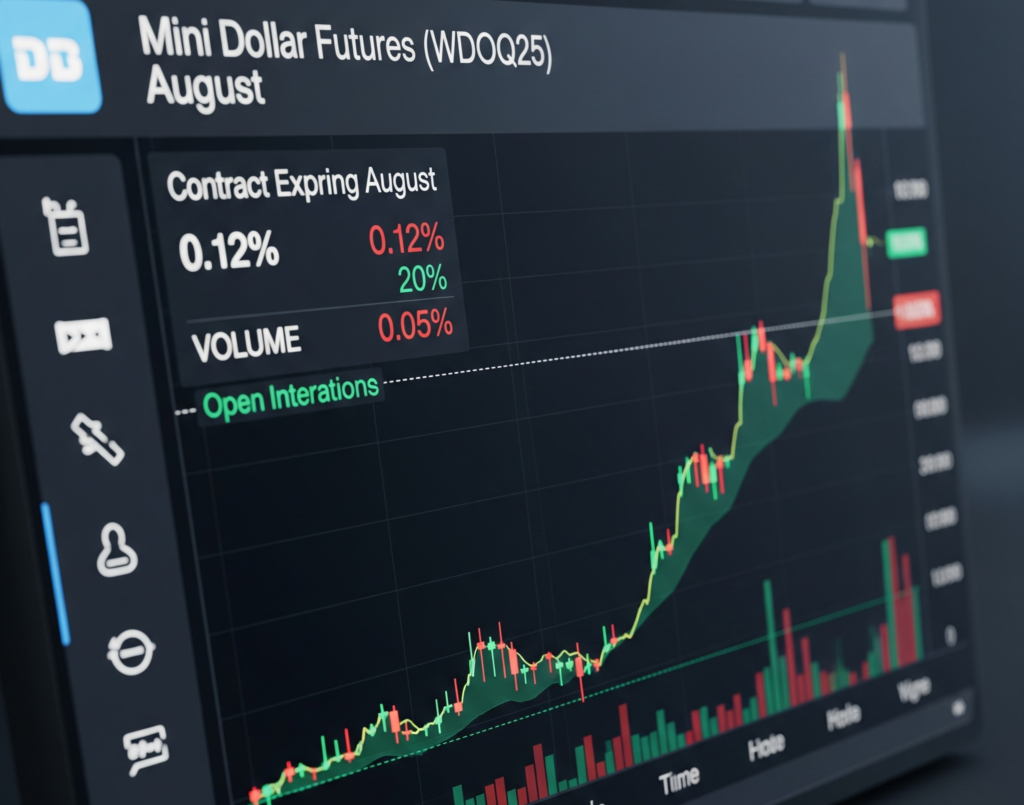
In the high-stakes world of financial markets, few instruments attract as much attention as the Mini Dollar futures contract, especially when approaching expiration. The WDOQ25, which refers to the Mini Dollar futures expiring in August 2025, has recently captured traders’ interest due to its notable movement in the final minutes of trading — a 0.12% increase just before the close. But what does this mean for investors, and what factors contributed to this surge? Let’s dive into the dynamics behind this movement with a detailed, insightful analysis.
Understanding the Mini Dollar Futures Contract
First, a quick refresher: the Mini Dollar futures (ticker: WDO) are standardized contracts traded on the BM&FBOVESPA (Brazilian stock exchange), allowing traders to hedge against or speculate on the USD/BRL exchange rate. The “Q25” in WDOQ25 indicates the August 2025 expiration — meaning the contract’s delivery date is set for August 2025. These contracts are highly liquid, accessible for retail traders, and serve as an essential tool for managing currency risk or taking speculative positions.
The Significance of Expiration
Futures contracts have expiration dates, after which the contract settles either physically or financially. As expiry approaches — especially for contracts with longer-term maturities like August 2025 — traders often adjust their positions, leading to increased volatility. The final minutes of trading are particularly critical, as institutions and retail traders finalize their strategies, sometimes triggering sharp movements.
The Recent Movement: A 0.12% Rise in Last Minutes
On the recent trading day, the WDOQ25 experienced a modest yet notable increase of 0.12% in the final minutes. At first glance, such a movement might seem small, but in the context of currency futures, it’s significant. Small percentage shifts can translate into substantial gains or losses, especially when leverage is involved.
This last-minute surge reflects a confluence of factors: market sentiment shifting, macroeconomic data releases, geopolitical developments, and technical trading signals. Let’s analyze these components one by one.
Market Sentiment and Macro Factors
Brazilian and global economic indicators heavily influence the Mini Dollar futures. Recent macroeconomic data, such as inflation reports, employment figures, and GDP growth rates, have created a nuanced environment. For August 2025 contracts, traders are also considering the Federal Reserve’s monetary policy stance, the US dollar’s broad strength, and Brazil’s fiscal health.
In particular, a recent uptick in global risk appetite — perhaps fueled by easing inflation concerns or positive geopolitical news — can boost the US dollar’s strength relative to other currencies, including the Brazilian Real. Conversely, domestic political developments, monetary policy expectations from the Central Bank of Brazil, and external economic shocks can sway traders’ positions.
Technical Analysis and Trading Dynamics
Technical analysis plays a crucial role during the closing minutes. Traders often monitor key levels — support and resistance — and trading volumes to inform their final trades. The 0.12% increase might have been triggered by traders executing buy orders at critical support levels, anticipating continued upward movement, or closing short positions.
Moreover, algorithmic and high-frequency trading algorithms tend to execute large volumes in the final moments to capitalize on short-term price movements. These algorithms often respond to minute-by-minute technical signals, contributing to sudden surges or drops.
The Role of Liquidity and Market Participants
Liquidity is typically highest in the final minutes of trading, attracting both institutional investors and retail traders. Large players may execute strategic trades to hedge positions ahead of settlement or to capitalize on anticipated market moves.
The participation of foreign investors, hedge funds, and local traders creates a vibrant trading environment. Their collective actions, driven by macroeconomic data and technical signals, can cause the small yet impactful 0.12% movement observed.
Why Does the Final Minute Movement Matter?
While a 0.12% move may seem minor, it’s crucial in the context of futures trading, where leverage amplifies gains and losses. For traders holding long or short positions, such movements determine profitability or risk exposure.
Furthermore, these final-minute swings often set the tone for the next trading session. They reflect underlying market sentiment and can signal future trends. A positive close, even if small, can boost trader confidence, while a sudden spike might lead to increased volatility in subsequent sessions.
Broader Market Implications
This movement in WDOQ25 is also a barometer of broader market expectations. A slight uptick suggests cautious optimism among traders about the Brazilian economy and the global environment. It may also indicate that traders are adjusting their positions ahead of upcoming economic data releases or policy meetings.
In addition, the movement sheds light on the importance of timing and strategic execution in futures trading. Recognizing when to enter or exit positions can make the difference between profit and loss, especially in volatile periods.
Looking Ahead: What’s Next for WDOQ25?
As the August 2025 expiration approaches, traders should remain attentive to macroeconomic developments, geopolitical events, and technical signals. The recent 0.12% increase might be a prelude to further volatility or simply a consolidation phase.
Investors should also consider the broader trend: Is the Mini Dollar maintaining its upward momentum, or are we witnessing a temporary correction? Continuous monitoring of economic indicators, Central Bank statements, and global risk sentiment is essential for informed decision-making.
Final Thoughts
The last-minute 0.12% rise in the Mini Dollar futures contract (WDOQ25) with August expiration exemplifies the dynamic nature of currency futures trading. It underscores the importance of timing, technical analysis, and macroeconomic awareness in navigating these markets. Whether you’re a seasoned trader or a curious observer, understanding these movements provides valuable insights into the complex interplay of factors influencing the USD/BRL exchange rate.
In the end, such movements are more than just numbers; they are reflections of global economic realities, investor sentiment, and strategic positioning. As the market continues to evolve, keeping an eye on these subtle yet impactful shifts will remain vital for anyone involved in the currency futures landscape.
